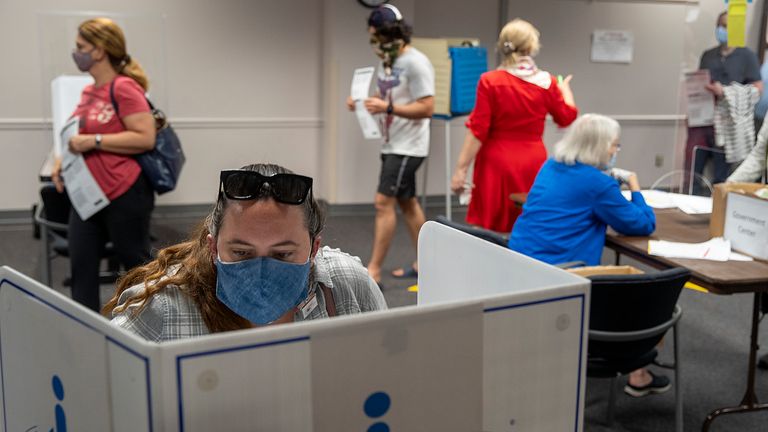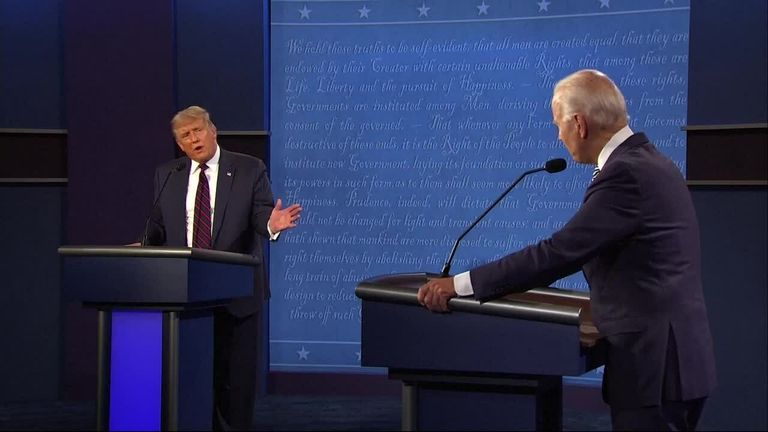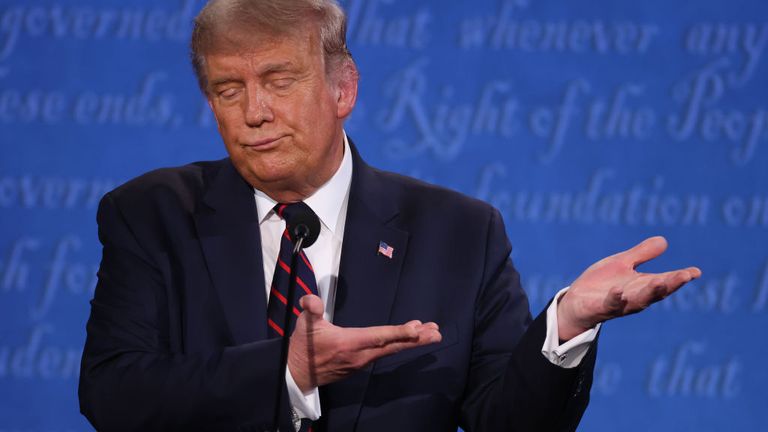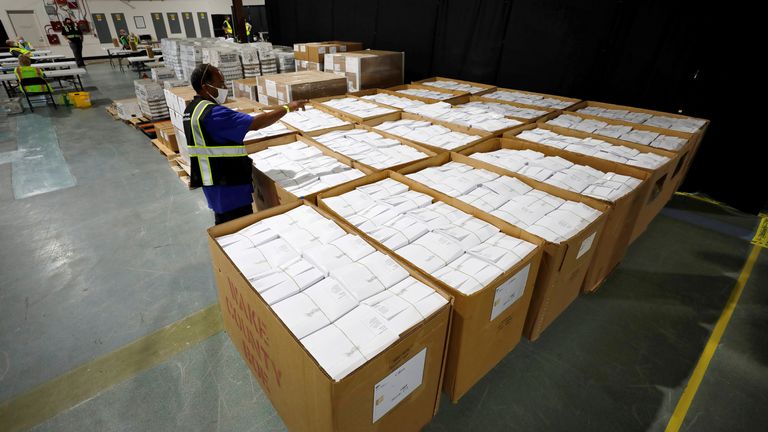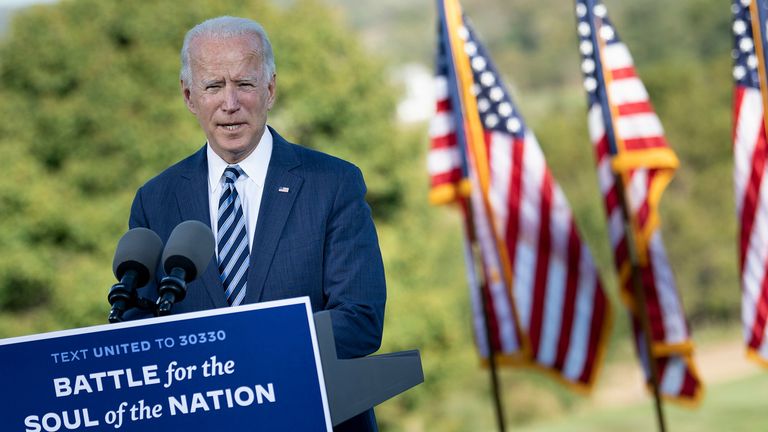US election 2020: How does polling work and who is ahead?
As the race for president ramps up, you will hear a lot about polls ahead of the big day on 3 November.
Sky News looks into what the point of polling is and what the landscape is like for Democrat Joe Biden and Republican Donald Trump.
What are the polls saying?
National polls up to 5 October have Mr Biden leading substantially over Mr Trump, from between eight points and 16 points ahead of the president.
“The chance anyone loses the Electoral College when up eight points nationally is basically nil,” CNN’s political forecaster Harry Enten said.
But, there is still just under a month to go until the election on 3 November.
Where have Trump and Biden been in the polls during key moments of the campaign?
Using data from poll analysis website Fivethirtyeight, Sky News has pinpointed some of the key moments to track how the two candidates have been doing in the polls.
1 June: Biden 70% Trump 30%. Following a week of nationwide protests over the killing of black man George Floyd by a police officer
29 June: Biden 79% Trump 21%. Coronavirus cases reach a record high of 40,000 daily infections
6 July: Biden 72% Trump 28%. Poll reactions after both candidates speak on Fourth of July, with Biden focusing on hope and unity and Trump speaks out about “leftists, looters and agitators”
7 August: Biden 70% Trump 30%. Trump says Biden is “against God” as he tries to make up ground in crucial Midwestern states
1 September: Biden 69% Trump 31%. Trump defends the alleged shooting of two men by one of his supporters
11 September: Biden 75% Trump 24%. The pair avoid each other at a commemoration service for the 9/11 attack. Mr Biden has continued to increase his popularity since then
19 September: Biden 77% Trump 22%. Both candidates pay tribute to Supreme Court Justice Ruth Bader Ginsberg, a Democrat, who died the day before. Mr Biden says he is proud to be working class
1 October: Biden 80% Trump 20%. Following the first presidential debate two days before, Biden gets a boost while Trump’s popularity dips.
6 October: Biden 82% Trump 17%. The country reacts to Mr Trump being in hospital for COVID-19 then returning to the White House where many of his close aides test positive.
How does voting work in the US?
The US system works by people casting their vote for president – the popular vote.
Electors who represent their state’s vote then cast their vote in the Electoral College and it is those votes that determine who wins.
A candidate needs the votes of at least 270 electors – more than half of all electors – to win the presidential election. It is therefore possible to lose the popular vote – so less people actually vote for a candidate – but still win the election by earning more of the Electoral College votes, like Donald Trump did in 2016.
What are the swing state polls saying?
Swing states, also known as battleground or toss-up states, hold disproportionate sway in presidential elections and are decided by the Electoral College.
Millions of dollars are poured into campaigning in swing states as they can switch from one party to another in different elections, providing the valuable additional college votes needed to win the White House.
Here is how both men are doing in the 12 battleground states, according to Fivethirtyeight analysis:
Arizona – Biden to win (67% chance)
Florida – Biden to win (66% chance)
Georgia – Toss-up (Trump 55%, Biden 45%)
Iowa – Trump to win (63% chance)
Michigan – Biden (90% chance)
Minnesota – Biden to win (90% chance)
Nevada – Biden to win (85% chance)
North Carolina – Biden to win (59% chance)
Ohio – Toss-up (Biden 51%, Trump 49%)
Pennsylvania – Biden to win (83% chance)
Texas – Trump to win (71% chance)
Wisconsin – Biden to win (83% chance)
What does polling aim to do and how are polls conducted?
Political polling aims to predict which presidential candidate is most favoured at that time.
Professional pollsters rely on answers from a sample of people, this can be anywhere from a few hundred to more than 1,000, with the aim of representing a much larger population.
They use other data, such as past voting behaviour, to estimate the probability of who will cast a ballot as many more people say they will vote than actually do.
There is always a margin of error in polling, highlighted by two pollsters putting Hillary Clinton’s chances of winning the 2016 race at 99% – something which raised concerns over its efficacy. Mrs Clinton also lead in the polls for virtually the entire 2016 contest, but still lost in the Electoral College.
:: Subscribe to Divided States on Apple podcasts, Google Podcasts, Spotify, and Spreaker
However, experts found out that was because a higher proportion of undecided voters ultimately voted for Mr Trump over Mrs Clinton, most state polls over-represented college graduates and rural turnout was higher than expected and lower in urban counties.
In general, national polls are more accurate than state polls.
What happened last time?
In the 2016 presidential election, Mr Trump was up against Mrs Clinton and she won the popular vote by 2.87 million more votes.
However, Mr Trump received the majority of votes in the Electoral College, notably from the pivotal Rust Belt region, gaining 304 electoral votes in total while Mrs Clinton had 227.
Two “faithless electors” – those who defy who they pledged to vote for – defected from Mr Trump, while five defected from Mrs Clinton. All seven switched their vote to people not on the ballot.
In July, Supreme Court judges ruled that states can require their electors to cast their ballot for the candidate who won their state’s popular vote, therefore avoiding defections.
Thirty-three states, plus the District of Columbia, now have laws against faithless electors, although the laws in half of them have no enforcement mechanism.
Source: Read Full Article
